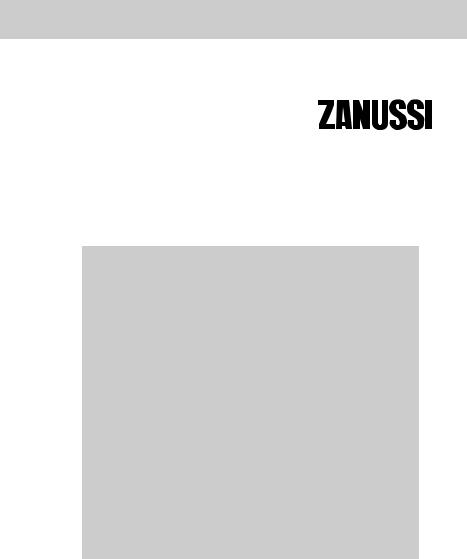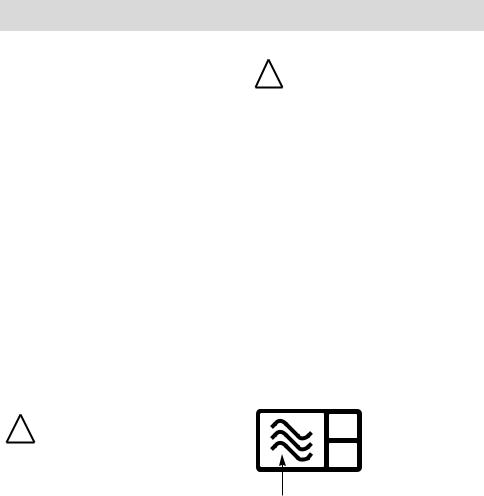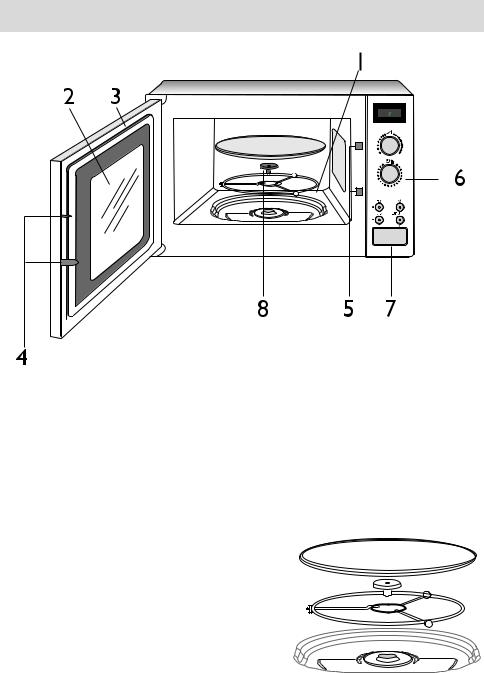Zanussi ZM24STW, ZM24STX, ZM24STN User Manual

INSTRUCTION MANUAL
MICROWAVE OVEN
ZM 24ST

ZM 24ST UK
Contents
For the user
Before using your microwave oven |
4 |
Charts |
|
|
|
|
Defrosting |
20 |
|
Safety Instructions |
5 |
Cooking vegetables |
22 |
|
Utensil safety |
6 |
Cooking fish |
22 |
|
Testing suitability of cookware |
6 |
|
|
|
Foil containers |
6 |
Care and cleaning |
23 |
|
Food safety |
7 |
Cleaning the accessories |
23 |
|
MAFF rating |
7 |
Cleaning the interior |
23 |
|
Oven utensils and accessories guide |
8 |
Cleaning the exterior |
23 |
|
Description of the microwave oven and |
Something Not Working |
24 |
||
accessories |
9 |
Service and Spare Parts |
24 |
|
The microwave oven |
9 |
Customer Care |
24 |
|
Accessories |
9 |
|
|
|
Control panel |
10 |
Guarantee Conditions |
25 |
|
|
|
Standard guarantee conditions |
25 |
|
Before using your microwave oven |
|
Exclusions |
25 |
|
for the first time |
|
|
|
|
Cleaning |
11 |
For the installer |
|
|
Setting the clock |
11 |
|
||
General operating instructions |
12 |
|
|
|
How to operate your microwave oven 14 |
Installation |
26 |
||
Electrical connections |
26 |
|||
Microwave cooking |
14 |
|||
Connecting to the mains |
26 |
|||
Microwave setting guide |
15 |
|||
Build-In model |
27 |
|||
Minute timer with alarm |
15 |
|||
Technical data |
27 |
|||
Automatic programmes |
16 |
|||
|
|
|||
Auto Defrost |
16 |
|
|
|
Quick Start |
16 |
|
|
|
Manual defrosting |
17 |
|
|
|
Automatic Cooking Programmes |
18 |
|
|
|
Child Lock |
19 |
|
|
|
Microwave Hints |
19 |
|
|
|
3

ZM 24ST |
UK |
|
|
Before using your microwave oven
Read through the instruction manual carefully. The following instructions have been prepared so that you get the best from your new Zanussi microwave oven. It is important that this instruction book is retained with the appliance for future reference. Should the appliance be sold or transferred to another owner, or if you move house and leave the appliance, always ensure that the book is supplied with the ap-pliance so that the new owner can become acquainted with the functioning of the appliance and the relevant warnings. Please ensure you have read the whole instruction book before using the appliance and that you follow the recommendations given.
Unpacking
N.B. When you unpack the oven, check that the product is free from damage. Damage or any missing parts must be reported immediately to the retailer. The oven, parts of the oven or the accessories may be wrapped by a protection foil. If present, you must remove this foil before using the oven. Do not leave packing material where small children can play with it. This can be hazardous.
4

ZM 24ST |
UK |
|
|
Safety Instructions
•The built-in safety interlock switches prevent the microwave oven from operating when the door is open.
•Do not tamper with them, nor attempt to operate the oven with the door open, as open door operation can result in exposure to microwave energy.
•Do not allow food spills or cleaner residue to accu-mulate on door sealing surfaces. See the Cleaning and Care section for cleaning instructions.
•It is particularly important that the oven door closes properly and that there is no damage to the:
(1)door (warped), (2) hinges and latches (broken or insecure), (3) door seals and sealing surface.
If the door, hinges/latches or door seals
!are damaged, the appliance must not be operated until it has been repaired by an authorized service engineer.
It is hazardous for anyone except
!factory trained service personnel to service or make adjustments to this oven. Contact your local Zanussi Service Force Centre if service should be required.
•Do not remove the outer case, door or control panel at any time. Doing so may cause exposure to extremely high voltage.
•Install or locate this oven only in accordance with ‘installation instructions’ found in this manual.
•Use the appliance for its intended use as described in this manual. Do not use corrosive chemicals in this appliance. This type of oven is specifically designed to heat, cook, or defrost food. It is not designed for industrial, laboratory, nor commercial use, as this will invalidate the guarantee.
•Do not operate the oven empty. If food or water is not present to absorb the microwave energy, the magnetron tube can be damaged.
•Do not store this appliance outdoors. Do not use this product near water.
•Do not attempt to dry clothing or newspapers in the microwave oven. These items can ignite.
•In order to evacuate moisture, your appliance is fitted with a delayed ventilation function. Depending on the applied cooking mode (solo / grill / combination), the oven ventilation will continue to operate after the cooking end. It switches off automatically after 3 minutes.
•Do not use the cavity for storage purposes. Do not leave paper products, cooking utensils, or food in the cavity when not in use.
If smoke is observed, switch off or
!unplug the appliance and keep the door closed in order to stifle any flames. Never use water.
Do not allow children to use the
!microwave without supervision until adequate instructions have been given so that the child is able to safely operate the microwave and understands the hazards of improper use.
5

ZM 24ST |
UK |
|
|
Safety Instructions
Utensil safety
•Most glass, glass ceramic and heat-resi- stant glassware utensils are excellent for use in the microwave oven. Although microwave energy will not heat most glass and ceramic items, these utensils can become hot as heat transfers from the food to the container. Use oven gloves to remove dishes.
Testing suitability of cookware
•Place the cookware in the microwave along with a glass half full of water. Heat on 900W (100%) for one minute. If the cookware feels hot, you should not use it. If it is just slightly warm, you can use it for reheating but not for cooking. If the dish is at room temperature, it is suitable for microwave cooking.
•Paper napkins, wax paper, paper towels, plates, cups, cartons, freezer wrap and cardboard are great convenience utensils. Always be sure containers are filled with food to absorb energy and thus avoid the possibility of overheating.
•Many plastic dishes, cups, freezer containers and plastic wraps may be used in the microwave oven. Follow manufacturer’s instructions when using plastics in the oven. Avoid using plastic utensils with foods that have high fat or sugar content since these foods reach high temperatures and could melt some plastics.
•Do not leave the oven unattended when heating or cooking food in plastic, paper or other combustible containers.
•Metal containers and containers with metallic trim should not be used in the microwave oven, unless specifically
recommended for microwave use.
•Containers with restricted openings, such as bottles, should not be used for microwave cooking.
•Use caution when removing a lid or cover from a dish to avoid steam burns.
Foil containers
Shallow foil containers may safely be used to reheat foods in your microwave oven providing the following rules are observed:
1.Foil containers should not be more than 3 cm (1¼”) deep.
2.Foil lids must not be used.
3.The foil containers must be at least twothirds full of food. Empty containers must never be used.
4.Foil containers should be used singly in the microwave oven and should not be allowed to touch the sides. If your oven has a metal turntable or cooking rack, the foil container should be placed on an upturned ovenproof plate.
5.Foil containers should never be re-used in the microwave oven.
6.If the microwave oven has been in use for 15 minutes or more, allow it to cool before using it again.
7.The container and turntable may become hot during use, take great care when removing either from the oven. It is advisable to use an oven cloth or glove when doing so.
8.Remember when using an aluminium foil container that the reheating or cooking times may be longer than those you are used to, always ensure that the food is piping hot before serving.
6

ZM 24ST |
UK |
|
|
Safety Instructions
Food safety
•Do not heat food in a can in the microwave oven. Always remove the food to a suitable container.
•Do not use the appliance for deep fat frying, because the fat temperature cannot be controlled, and hazardous situations can result.
•Popcorn may be prepared in the microwave oven, but only in special packages or utensils designed specifically for this purpose. This cooking operation should never be left un attended.
•Pierce foods with non-porous skins or membranes to prevent steam build-up and bursting. Apples, potatoes, chicken livers, and egg yolks are examples of items that should be pierced.
•The contents of feeding bottles and baby food jars are to be stirred or shaken and the temperature is to be checked before consumption, in order to avoid burns.
!sauces and beverages in your microwave oven, overheating the liquid beyond boiling point can occur without evidence of bubbling. This could result in a sudden boil over of the hot liquid. To prevent this possibility the following steps should be taken:
1.Avoid using straight-sided containers with narrow necks.
2.Do not overheat.
3.Stir the liquid before placing the container in the oven and again halfway through the heating time.
4.After heating, allow to stand in the oven
for a short time, stirring again before carefully removing the container.When heating liquids, e.g. soups,
!and sealed containers – for example, closed glass jars – may explode and should not be heated in this oven. Occasionally, poached eggs may explode during cooking. Always pierce the yolk, then cover and allow
the standing time of one minute before removing cover.Some products such as whole eggs
Keep these instructions!
MAFF Rating
Explanation of the heating category label for micro-wave ovens and small packs of food (up to 500g/1lb, typical of ready meals for 1 or 2 people) as agreed by MAFF (the Ministry of Agriculture Fisheries and Food) in conjunction with food and Microwave Oven manufacturers.
900W Power Rating in Watts
E Heating Category
Microwave Symbol
Always follow food manufacturers instructions when cooking ready meals.
Always ensure that food is piping hot before serving.
N.B. The higher the power output and heating category of the microwave oven, the less heating time is required.
7

ZM 24ST |
UK |
|
|
Oven utensils and accessories
guide
A variety of utensils and materials may be
used for cooking in your microwave oven.
For your safety and to prevent damaging
utensils and your oven choose appropriate
utensils and materials for each cooking met-
hod. The list below is a general guide.
Material |
Utensils |
Defrosting |
Heating |
Cooking |
|
|
|
|
|
|
|
Ceramic & Glass |
Corning ware |
|
YES |
YES |
YES |
Heat resistant |
|
|
|
|
|
glass ware |
|
|
YES |
YES |
YES |
Glass ware with |
|
|
|
|
|
metal decoration |
|
|
NO |
NO |
NO |
Lead crystal glass |
|
|
NO |
NO |
NO |
China |
Without metal |
|
|
|
|
|
decoration |
|
YES |
YES |
YES |
Pottery |
|
|
YES |
YES |
YES |
Plastic |
Microwave oven |
|
|
|
|
|
heat-proof wear |
|
YES |
YES |
YES |
|
Plastic wrap |
|
YES |
YES |
YES |
Metal |
Metal baking pan |
|
NO |
NO |
NO |
|
Aluminium foil* |
|
YES |
YES |
NO |
Paper |
Cups, plates, towels |
YES |
NO |
NO |
|
Waxed paper |
|
|
YES |
YES |
YES |
Wood |
|
|
NO |
NO |
NO |
Accessories |
Turntable |
|
YES |
YES |
YES |
|
Turntable support |
|
YES |
YES |
YES |
|
|
|
|||
YES: Utensils and accessories to use |
|
NO: Utensils and accessories to avoid |
|||
*NOTE: Use aluminium foil only for shielding purposes, overuse may cause arcing.
8

ZM 24ST |
UK |
|
|
Description of the microwave oven and accessories
8888
The microwave oven
1 Cooking compartment
2Viewing window
3Oven door
4Door catch
5Safety interlock system
6Control panel
7Door open button
8Drive shaft for turntable
Accessories
Turntable and turntable support
The turntable and turntable support should be
installed as shown in the diagram. Take care to
ensure the turntable support is properly in place.
The turntable may turn clockwise or counterclock-
wise during operation. Do not rotate the turntable
manually, as you could damage the drive system.
9
